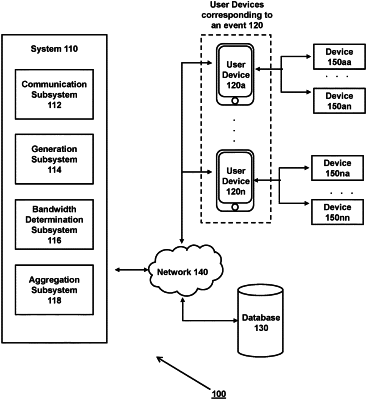| CPC H04L 41/16 (2013.01) [G06F 18/214 (2023.01); G06N 20/00 (2019.01); H04L 41/0896 (2013.01)] | 20 Claims |

|
1. A system for modifying scheduled events based on bandwidth availability, the system comprising:
determining, based on user device inputs indicating a participation at an event, a plurality of user devices corresponding to the event, wherein the event occurs at a first time;
receiving, at a second time, first network conditions for a first user device of the plurality of user devices, wherein the second time is prior to the first time, wherein the first network conditions indicate a level of background noise at a location of the first user device;
generating a feature input based on the first network conditions;
inputting the feature input into an artificial intelligence model to determine a first available bandwidth metric for the first user device, wherein the artificial intelligence model is trained to determine available bandwidth metrics based on historic network conditions corresponding to a plurality of previous events and event modification data for the plurality of previous events by:
receiving a first training dataset comprising the historic network conditions corresponding to the plurality of previous events for the first user device, wherein historic network conditions indicate a respective available bandwidth of the first user device at a time of a respective previous event;
receiving a second training dataset comprising the event modification data for the plurality of previous events for the first user device, wherein the event modification data indicates whether the respective previous event was modified;
training the artificial intelligence model to determine an amount of network conditions likely to correspond to modification of an upcoming event by the first user device;
aggregating the first available bandwidth metric with respective available bandwidth metrics for other user devices of the plurality of user devices to determine a composite available bandwidth metric for the plurality of user devices;
comparing the composite available bandwidth metric to a threshold available bandwidth metric; and
in response to determining that the composite available bandwidth metric equals or exceeds the threshold available bandwidth metric, generating for display, on a user device interface, a recommendation for modifying the event.
|